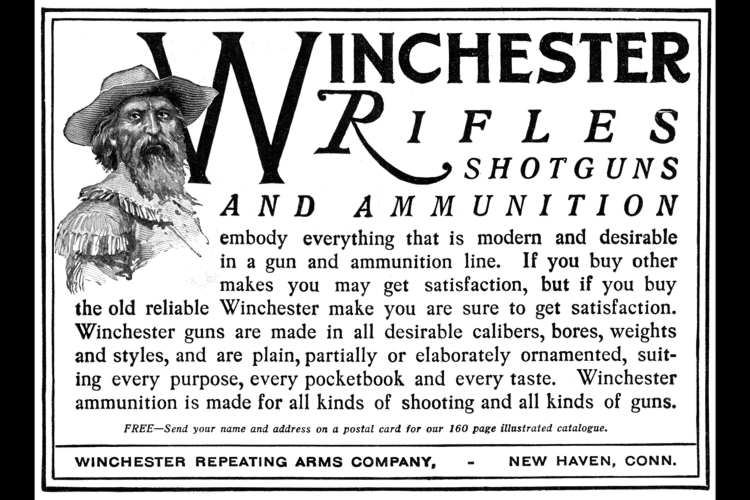
The .30-03 Springfield, originally developed in 1903, wasn't a overly successful cartridge. But while it may have ultimately failed as a cartridge, the unique case would subsequently be utilized in several successful designs. Three years removed from its debut and failure, we saw the impressive .30-06 replace the .30-03 and remain in service until the Korean War. Another, albeit less direct, example would be the .308 Winchester. Now in 1923, the Winchester Repeating Arms Company began development of yet another rifle cartridge, this time using a 7mm (.277”) bullet with the aforementioned parent .30-03 case which would debut in 1925 for the such chambered Model 54 rifle. Intended at the time to provide hunters with a cartridge capable of tackling large game at longer distances, the performance of the .270 Winchester was noteworthy for its time.
Commercially speaking, it wasn't an instant success. This may have been thanks to sheer volume of .30-06 available to sport shooters from surplus stocks and the long-held establishment of the .30-30 as the preeminent hunting cartridge. Couple that with the looming market crash and the Second World War to follow (where the .270 wasn't used), you see why. In the decades following the war, the .270 Winchester began to gain notoriety and it could be suggested thanks in large part to Jack O'Connor. For those who don't recognize the name, he was an outdoorsman and author best known for his work with Outdoor Life Magazine, one of the three largest magazines of its type in the United States. Of his years of work there, 31 were spent as the shooting editor for the magazine in which he frequently sang the praises of the .270, all the while familiar with the qualities of the .30-06 and later the .308 when it arrived on scene. But why exactly?
This paved way for a series of disagreements, something which persists today as is evident by going on the Internet and its many gun related forums. In fact, Internet forums may be exclusively for arguments - period. The same could be said of Youtube comment sections and Facebook posts for that matter. But back on subject, perhaps we here at Calibre can shed light on the subject?
In terms of bullet performance, comparing the .270 to that of the .30-06 or .308 sees negligible differences with 150 grain loads of similar commercially produced ammunition. Inside 300m, all three see velocities sitting within 100fps of one another with a slightly higher variation in energy delivery numbers. With the .270 sitting in the middle of the pack at 2850fps and 2700lbs inside 300m, it doesn't particularly stand out. Obviously, if we speak of performance, the ultimate quality is accuracy and let us be plainly clear that such will have far more to do with the quality and condition of the rifle- which is not to forget the shooter.
Like most popular hunting cartridges, the .270 offers a variety of loads to maximize effectiveness at a variety of game. Loads most commonly sit between 90 and 150 grain and is reasonably cheap at roughly a dollar and change per bang, not much unlike the .30-06 or the .308. But unlike the .270, the .30-06 and .308 see more options for shooters, particularly above the 150 grain mark. As such, this make them the logical preference for game as large as elk and above even if the .270 Winchester is capable of game that size.
Is the .270 inherently more accurate? At the aforementioned range, it really isn't. Any modern hunting cartridge or ammunition of similar quality to that of the .270 will be mutually capable of being accurate – which includes the .30-06 and the .308 thanks to their mutual evolution of manufacturing process, bullet, and powder innovation. If one evaluates the typical line up of rifles chambered for .270 Winchester, you get an impressive list which will also include .270 WSM and -06 Wildcat options. On the high end of the scale we see the Blaser R8 and the very affordable Remington 783 on the bottom end; not to forget Ruger's M77, Browning's A-Bolt, Weatherby's Vanguard S2, Sako's 85M, or the Sauer 101 as other excellent options. Hardly a mediocre lineup to say the least.
We can't help but speculate that far too much of the praises hinged on comparisons of the .270 in its typical, well made bolt-action rifle built to spec to numbers captured from military battle rifles, for which the .30-06 and .308 were originally intended. It should be no mystery that a positive correlation will exist between rifles manufactured to tighter tolerances and potential accuracy. Military rifles are not, given both the manufacturing process and the intent. Case and point: the Ross Mk III. What we don't speculate, however, is the accuracy potential of .30-06 and .308 when used in combination with modern hunting rifles as well.
So where's the benefit? Were O'Connor's praises merited by fact?
As best we can tell, yes and no. I know you may have been expecting something a little more concrete... Okay, okay – definitive; but, like anything, it mostly comes down to personal preference. Ultimately, and predictably, the .270 Winchester is better at longer ranges (even if slightly so on a level playing field) - as was its design purpose. Its trajectory is comparably flatter thanks to its ability to sustain velocity at greater distances and for hunters who frequent open ranges or are preferable to long range hunting, the .270 is a no brainer. Targets as far as 800m will see consistent bullet delivery on target with sufficient energy to drop game. If we had to pick a cartridge based merely on performance versatility, the .270 would have a slight edge. Otherwise, application versatility would see a debate rise up between the .30-06 and the .308. And who wants that?